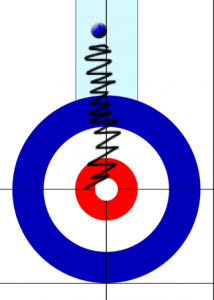While attending the Level 3 Technical coaching course in Napanee the last weekend in October, Brian Savill gave us a one-hour “Sweeping Update”, summarizing the latest research undertaken at the University of Western Ontario on the mechanics of brushing and its best practices. I’d like to summarize Brian’s remarks here. There is some other online material available about the UWO study, including a useful article by Scott Arnold of the World Curling Federation.
Qualities of effective sweeping
To be effective, sweeping requires the optimization and balance of the following factors:
- Downward pressure
- Brushing technique:
- Orientation of the broom
- Brush-head speed
- Length of brushing stroke
- Proximity of the brush to the stone
- Orientation of the two sweepers, both to maximize effect and minimize the risk of touching any stone
- Weight judgment
- Communication amongst all four players
- Footwork:
- Being able to keep up with the stone, even if thrown with peel weight
- Negotiating around guards while still sweeping
- Effective footwork in both the closed and open positions
- Endurance
Finer points of effective sweeping
The UWO study, commissioned by the Canadian Curling Association, studied a wide variety of variables from the points listed above, with both club curlers and highly-skilled curlers from Tour events. The study noted – unsurprisingly – that there exists a strong correlation between the frequency of the brushing stroke and the amount of heat generated. Also, shorter brush strokes tend to be counterproductive because shorter strokes often lead to other adjustments by the player that alters the overall amount of effort put into it.
One of the more interesting variables analyzed in the UWO study was the orientation of the brush head. The two extremes are (a) holding the brush so that the head is perpendicular (across, or 90 degrees) to the line of travel and (b) holding the brush so that the head is parallel to the line of travel.
If the brush is held so that the head is perpendicular to the line of travel, the UWO researchers found that the brush warms the ice to a slightly higher temperature, and it permits the inside brusher to hold the brush head slightly closer to the stone. However, the disadvantage of this orientation is that the brush warms the ice in a “zig-zag” pattern (see the diagram at left) leading to inconsistent warming of the entire path in front of the stone. Moreover, the research team found that the stroke width is much harder to control with the perpendicular orientation.
A parallel orientation, on the other hand, raises the ice temperature a fraction of a degree less than the perpendicular orientation, but offers greater consistency and much better control of the width of the stroke.
The UWO study concluded that in their experiments the most effective orientation for two sweepers is as follows: the inside sweeper brushes next to the stone with the brush head parallel to the line of travel; and the outside sweeper, brushing on the opposite side, holds their brush at a 45-degree angle to the line of travel. Where the ice has some amount of frost, the use of a hair brush by the outside sweeper (again, at a 45-degree angle) is the most effective.
Newer brush heads make a difference
Another assessment performed by the UWO team was on particular types of brush heads. In the past year, these new heads, originally designed and manufactured by Balance Plus and now also offered as Goldline “HE” heads, require less effort to achieve the same efficiency, and are waterproof – a problem with regular nylon heads is that, once wet, they are much less efficient than when they are dry.
The new heads are slightly more expensive than regular nylon, but tend to last much longer.
Corner sweeping
In the past, both the World Curling Federation and the Canadian Curling Association mandated that brushing had to involve strokes that took the brush head completely across the running path of the stone. In the parlance of the day, “snowplowing” and “corner sweeping” – sweeping only a partial path – were illegal. These rules were changed a few years ago and now “anything goes” except that one must not purposefully stop their brush in front of a stone with the intent to “dump” debris in front of the stone to slow it down.
With “corner sweeping”, there are two orientations: “low-side” and “high-side”. The “low-side” is that part of the stone closer to the direction of curl; the “high-side” is, of course, the opposite side. The UWO study found that corner sweeping on the “low-side” of a stone tended to make the rock go straighter, but since the brushing effect was not on the entire running path of the stone, the stone would not carry down the sheet as far. Conversely, “corner sweeping” on the “high-side” would cause the stone to carry further than with “low-side”, and in addition cause the stone to curl more than when brushing across the complete running path of the stone.
“Corner sweeping” is now used by teams on Tour quite deliberately. Its impact when attempted by younger players is unknown, but anecdotal evidence suggests that corner sweeping can make an impact even with the reduced downward pressure applied by younger players.

I have often been accused of sweeping to much, too little or too late – seems to be a ‘curling’ thing!
Since I am in my 60’s, quite fit but only 115 lbs, I always wonder if my sweeping has any effect all.
I haven’t been able to find any research involving club curlers but am curious to know.
If you could direct me to information or email me with your findings, I would appreciate it.
Yours truly,
Kathryn Markle